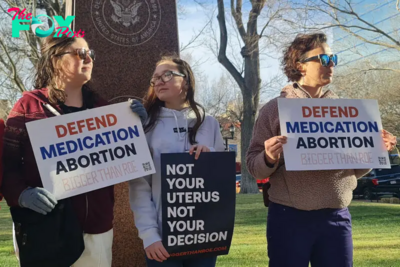Politics
An unseen problem with the Electoral College – it tells bad guys where to target their efforts
Over the past four years, Congress and state governments have worked hard to prevent the aftermath of the 2024 election from descending into the chaos and threats to democracy that occurred around the 2020 U.S. presidential election.
A new federal law cleaned up ambiguities that could allow for election subversion. New state laws have been enacted across the country to protect election workers from threats and harassment. Technology experts are working to confront misinformation campaigns and vulnerabilities in election systems.
But untouched in all of these improvements is the underlying structure of presidential elections – the Electoral College.
Here is a quick refresher about how the system works today:
After citizens vote in the presidential election in November, the Constitution assigns the task of choosing the president and vice president to electors. Electors are allocated based on the number of congressional representatives and senators from each state. The electors meet in their separate state capitals in December to cast their votes. The ballots are then counted by the vice president in front of members of Congress on Jan. 6 to determine which ticket has won a majority.
The widely varied pros and cons of the Electoral College have already been aired and debated extensively. But there is another problem that few have recognized: The Electoral College makes American democracy more vulnerable to people with malicious intent.
A state-centric system
The original brilliance of the Electoral College has become one of its prime weaknesses. The unusual system was devised at the Constitutional Convention in 1787 as a compromise that prioritized the representation of state interests. This focus helped win over reluctant delegates who feared that the most populous states would disregard small states’ concerns.
Nowadays nearly every state has chosen to award all of its electoral votes to whichever ticket wins more votes in the state. Even if a candidate gets 51% of the popular vote, use of the winner-take-all rule in these states means they will be awarded 100% of the electoral votes.
This is what leads to the “battleground state” phenomenon: Presidential candidates focus their rallies, advertisements and outreach efforts on the few states where campaigns could actually tip the balance. In 2020, 77% of all campaign ads ran in just six states that were home to only 21% of the nation’s population.
In this way, the Electoral College system naturally draws campaign attention to issues that might tip the balance in these hotbeds of comPetitiveness.

A road map for bad behavior
By doing so, the system essentially identifies the states where malicious people who want to alter or undermine the election results should focus their energies. The handful of battleground states are efficient targets for harmful efforts that would otherwise not have much success meddling in elections.
Someone who wants to infiltrate the election system would have difficulty causing problems in a national popular vote because it is decided by thousands of disconnected local jurisdictions. In contrast, the Electoral College makes it convenient to sow mischief by only meddling in a few states widely seen as decisive.
In 2020, the lawsuits, hacking, alternative electors, recount efforts and other challenges did not target states perceived by some to have weaker security because they had less strict voter ID laws or voter signature requirements. Opponents of the results also did not go after states such as California and Texas that account for a large share of the country’s voters.
Rather, all of the firepower was trained on about a half-dozen swing states. By one account, there were 82 lawsuits filed in the days after the 2020 presidential election, 77 of which targeted six swing states. The “fake elector” schemes in which supporters of Donald Trump put forward unofficial lists of electors occurred in only seven battleground states.
The popular vote alternative
A majority of Americans say in surveys they prefer to scrap the Electoral College system and simply award the presidency to the person who gets the most votes nationwide.
Dumping the Electoral College would have a variety of consequences, but it would immediately remove opportunities for disrupting elections via battleground states. A close election in Arizona or Pennsylvania would no longer provide leverage for upending the national result.
Any election system that does not rely on states as the puzzle pieces for deciding elections would remove opportunities like these. It could also seriously reduce disputes over recounts and suspicion about late-night ballot counts, long lines and malfunctioning voting machines because those local concerns would be swamped by the national vote totals.
Although not without its own concerns, an agreement among the states to award their electoral votes to the winner of the popular vote is probably the most viable method for shifting to the popular vote, in part because it does not require passing an amendment to the Constitution.
There is no ideal way to run a presidential election. The Electoral College has survived in its current form for almost two centuries, a remarkable run for democracy. But in an era where intense scrutiny of just a few states is the norm, the system also lights the way for those who would harm democracy.
-

 Politics1h ago
Politics1h agoWhy Trump Actually Needs Mexico
-

 Politics1h ago
Politics1h agoMan Convicted of Killing Laken Riley Sentenced to Life in Prison Without Parole
-

 Politics7h ago
Politics7h agoHow the Biden Administration Protected Abortion Pill Access—and What Trump Could Do Next
-

 Politics7h ago
Politics7h agoWhy Trump’s Tariffs Could Raise Grocery Prices
-

 Politics18h ago
Politics18h agoThe First Trans Member of Congress Expected Pushback Like Mace’s Bathroom Rule
-

 Politics18h ago
Politics18h agoNew York Prosecutors Oppose Dismissing Trump’s Hush Money Conviction
-

 Politics23h ago
Politics23h agoWhite House Christmas Tree Is a Symbol of Resilience for Hurricane-Hit North Carolina Farms
-

 Politics1d ago
Politics1d agoHakeem Jeffries Wins Reelection as House Democratic Leader Despite Party’s Losses





















